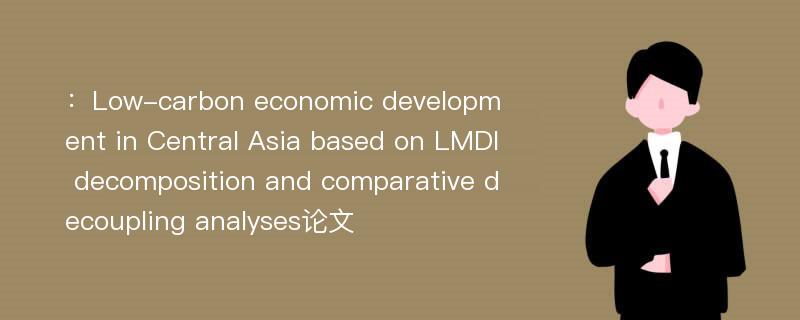
本文主要研究内容
作者(2019)在《Low-carbon economic development in Central Asia based on LMDI decomposition and comparative decoupling analyses》一文中研究指出:Low-carbon economic development is a strategy that is emerging in response to global climate change. Being the third-largest energy base in the world, Central Asia should adopt rational and efficient energy utilization to achieve the sustainable economic development. In this study, the logarithmic mean Divisia index(LMDI) decomposition method was used to explore the influence factors of CO2 emissions in Central Asia(including Kazakhstan, Uzbekistan, Kyrgyzstan, Tajikistan and Turkmenistan) during the period 1992–2014. Moreover, decoupling elasticity and decoupling index based on the LMDI decomposition results were employed to explore the relationship between economic growth and CO2 emissions during the study period. Our results show that the total CO2 emissions decreased during the period 1992–1998, influenced by the collapse of the Soviet Union in 1991 and the subsequent financial crisis. After 1998, the total CO2 emissions started to increase slowly along with the economic growth after the market economic reform. Energy-related CO2 emissions increased in Central Asia, mainly driven by economic activity effect and population effect, while energy intensity effect and energy carbon structure effect were the primary factors inhibiting CO2 emissions. The contribution percentages of these four factors(economic activity effect, population effect, energy intensity effect and energy carbon structure effect) to the total CO2 emissions were 11.80%, 39.08%, –44.82% and –4.32%, respectively, during the study period. Kazakhstan, Uzbekistan and Turkmenistan released great quantities of CO2 with the annual average emissions of 189.69×106, 45.55×106 and 115.38×106 t, respectively. In fact, their economic developments depended on high-carbon energies. The decoupling indices clarified the relationship between CO2 emissions and economic growth, highlighting the occurrence of a ’’weak decoupling’’ between these two variables in Central Asia. In conclusion, our results indicate that CO2 emissions are still not completely decoupled from economic growth in Central Asia. Based on these results, we suggest four key policy suggestions in this paper to help Central Asia to reduce CO2 emissions and build a resource-conserving and environment-friendly society.
Abstract
Low-carbon economic development is a strategy that is emerging in response to global climate change. Being the third-largest energy base in the world, Central Asia should adopt rational and efficient energy utilization to achieve the sustainable economic development. In this study, the logarithmic mean Divisia index(LMDI) decomposition method was used to explore the influence factors of CO2 emissions in Central Asia(including Kazakhstan, Uzbekistan, Kyrgyzstan, Tajikistan and Turkmenistan) during the period 1992–2014. Moreover, decoupling elasticity and decoupling index based on the LMDI decomposition results were employed to explore the relationship between economic growth and CO2 emissions during the study period. Our results show that the total CO2 emissions decreased during the period 1992–1998, influenced by the collapse of the Soviet Union in 1991 and the subsequent financial crisis. After 1998, the total CO2 emissions started to increase slowly along with the economic growth after the market economic reform. Energy-related CO2 emissions increased in Central Asia, mainly driven by economic activity effect and population effect, while energy intensity effect and energy carbon structure effect were the primary factors inhibiting CO2 emissions. The contribution percentages of these four factors(economic activity effect, population effect, energy intensity effect and energy carbon structure effect) to the total CO2 emissions were 11.80%, 39.08%, –44.82% and –4.32%, respectively, during the study period. Kazakhstan, Uzbekistan and Turkmenistan released great quantities of CO2 with the annual average emissions of 189.69×106, 45.55×106 and 115.38×106 t, respectively. In fact, their economic developments depended on high-carbon energies. The decoupling indices clarified the relationship between CO2 emissions and economic growth, highlighting the occurrence of a ’’weak decoupling’’ between these two variables in Central Asia. In conclusion, our results indicate that CO2 emissions are still not completely decoupled from economic growth in Central Asia. Based on these results, we suggest four key policy suggestions in this paper to help Central Asia to reduce CO2 emissions and build a resource-conserving and environment-friendly society.
论文参考文献
论文详细介绍
论文作者分别是来自Journal of Arid Land的,发表于刊物Journal of Arid Land2019年04期论文,是一篇关于,Journal of Arid Land2019年04期论文的文章。本文可供学术参考使用,各位学者可以免费参考阅读下载,文章观点不代表本站观点,资料来自Journal of Arid Land2019年04期论文网站,若本站收录的文献无意侵犯了您的著作版权,请联系我们删除。
